airbag MERCEDES-BENZ C-CLASS ESTATE 2011 Owners Manual
[x] Cancel search | Manufacturer: MERCEDES-BENZ, Model Year: 2011, Model line: C-CLASS ESTATE, Model: MERCEDES-BENZ C-CLASS ESTATE 2011Pages: 401, PDF Size: 9.74 MB
Page 7 of 401
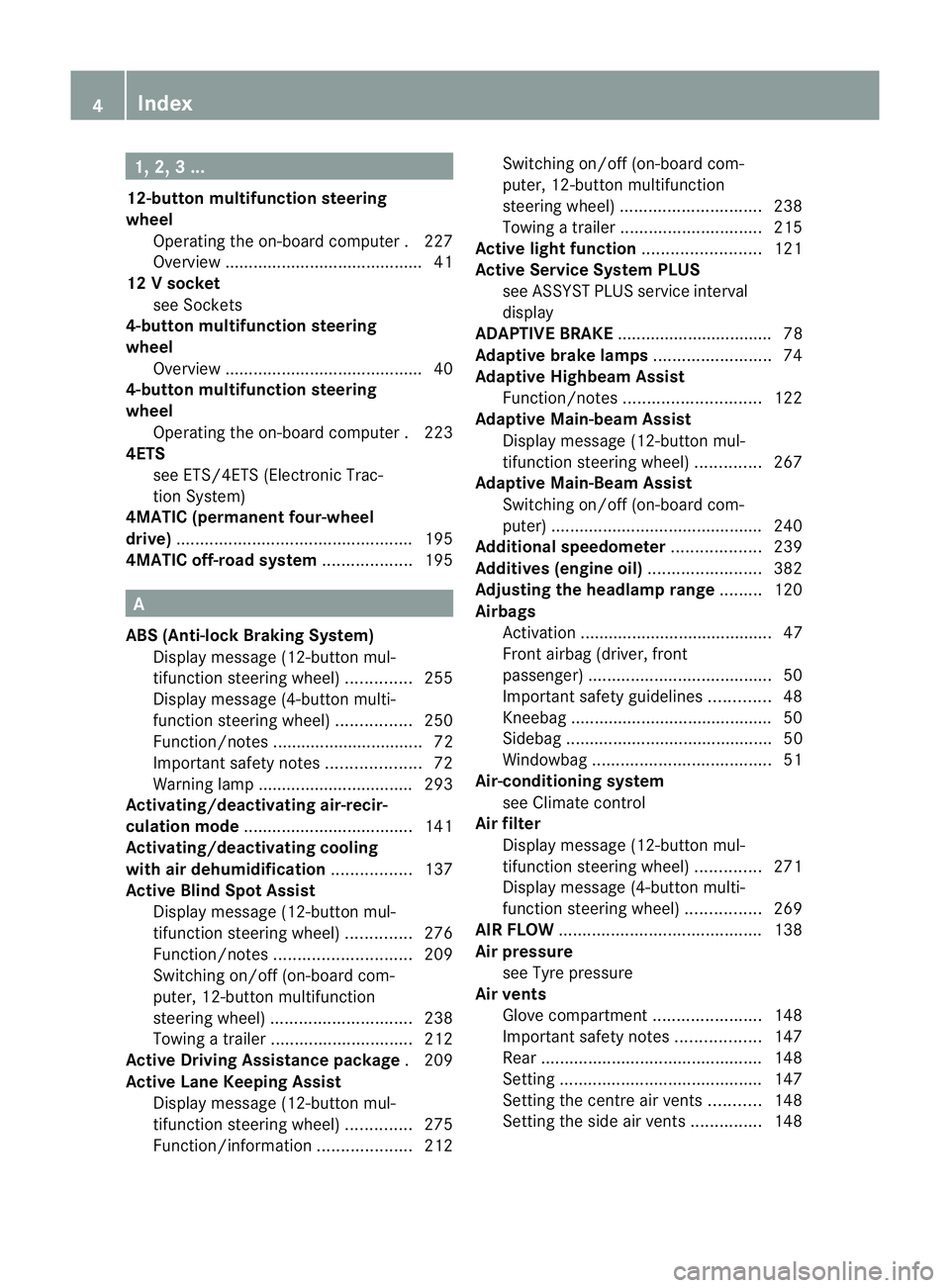
1, 2, 3 ...
12-button multifunction steering
wheel Operating the on-board computer .227
Overview .......................................... 41
12 Vsocket
see Sockets
4-button multifunction steering
wheel
Overview .......................................... 40
4-button multifunction steering
wheel
Operating the on-board computer .223
4ETS
see ETS/4ETS (Electronic Trac-
tion System)
4MATIC (permanent four-wheel
drive) .................................................. 195
4MATIC off-road system ...................195 A
ABS (Anti-lock Braking System) Display message (12-button mul-
tifunctio nsteering wheel) ..............255
Display message (4-button multi-
function steering wheel) ................250
Function/notes ................................ 72
Important safety notes ....................72
Warning lamp ................................. 293
Activating/deactivating air-recir-
culation mode .................................... 141
Activating/deactivating cooling
with air dehumidification .................137
Active Blin dSpot Assist
Display message (12-button mul-
tifunction steering wheel) ..............276
Function/notes ............................. 209
Switching on/off (on-board com-
puter, 12-button multifunction
steering wheel) .............................. 238
Towing atrailer .............................. 212
Active Driving Assistance package .209
Active Lane Keeping Assist Display message (12-button mul-
tifunctio nsteering wheel) ..............275
Function/informatio n.................... 212Switching on/off (on-board com-
puter, 12-button multifunction
steering wheel)
.............................. 238
Towing atrailer .............................. 215
Active light function .........................121
Active Service Syste mPLUS
see ASSYS TPLUS service interval
display
ADAPTIVE BRAKE .................................78
Adaptive brake lamps .........................74
Adaptive Highbeam Assist Function/notes ............................. 122
Adaptive Main-beam Assist
Display message (12-button mul-
tifunctio nsteering wheel) ..............267
Adaptive Main-Beam Assist
Switching on/off (on-board com-
puter) ............................................. 240
Additional speedometer ...................239
Additives (engine oil) ........................382
Adjusting the headlamp range .........120
Airbags Activation ......................................... 47
Front airbag (driver, front
passenger )....................................... 50
Important safety guidelines .............48
Kneebag .......................................... .50
Sidebag ............................................ 50
Windowba g...................................... 51
Air-conditioning system
see Climate control
Airf ilter
Display message (12-button mul-
tifunction steering wheel) ..............271
Display message (4-button multi-
function steering wheel) ................269
AIRF LOW ........................................... 138
Air pressure see Tyre pressure
Airv ents
Glove compartmen t....................... 148
Important safety notes ..................147
Rea r............................................... 148
Setting ........................................... 147
Setting the centre air vents ...........148
Setting the side air vents ...............148 4
Index
Page 21 of 401
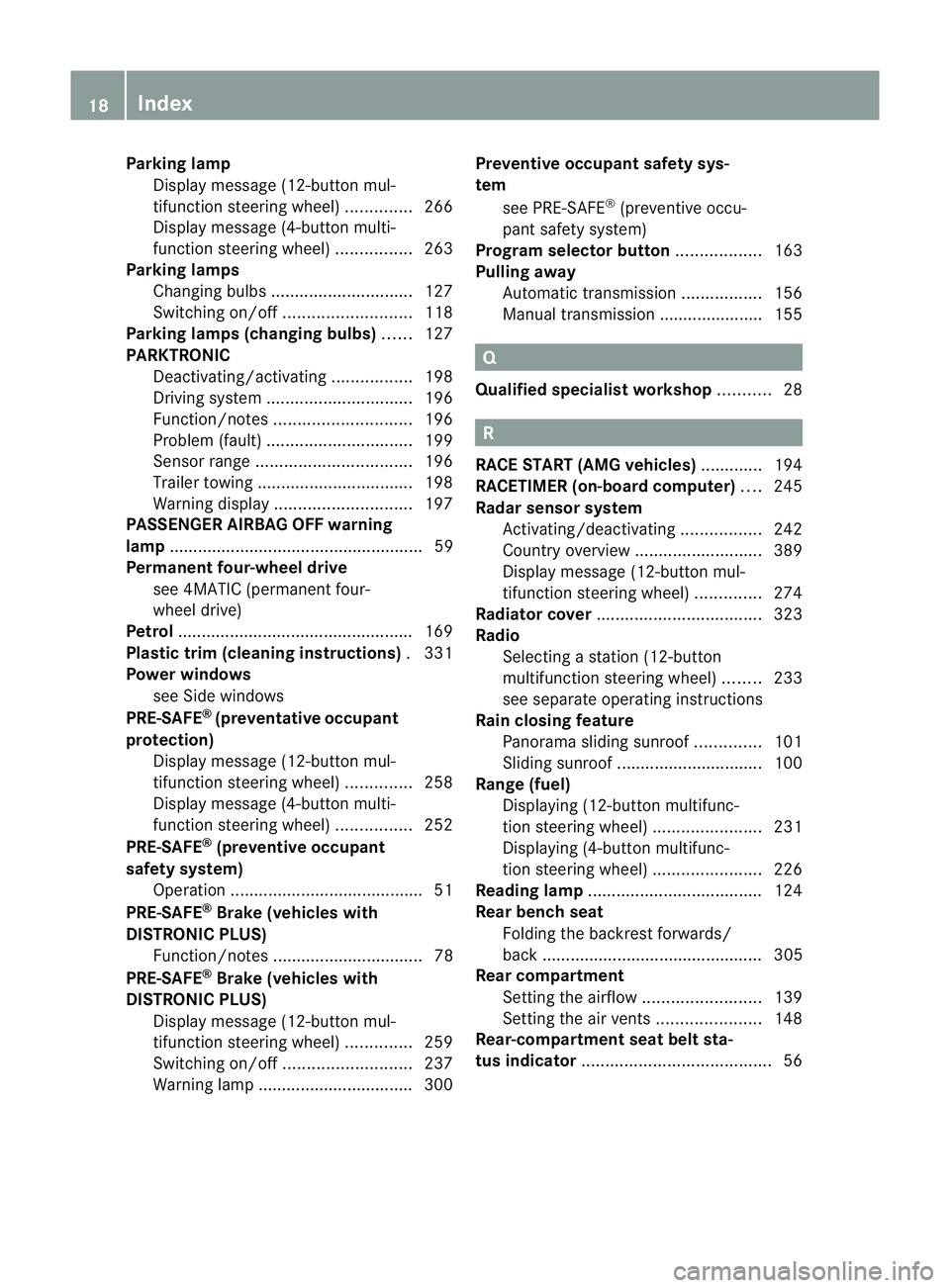
Parking lamp
Display message (12-button mul-
tifunction steering wheel) ..............266
Display message (4-button multi-
function steering wheel) ................263
Parking lamps
Changing bulbs .............................. 127
Switching on/off ........................... 118
Parking lamps (changing bulbs) ......127
PARKTRONIC Deactivating/activating .................198
Driving system ............................... 196
Function/notes ............................. 196
Problem (fault) ............................... 199
Sensor range ................................. 196
Trailer towing ................................. 198
Warning displa y............................. 197
PASSENGE RAIRBAG OFF warning
lamp ...................................................... 59
Permanent four-wheel drive see 4MATIC (permanen tfour-
wheel drive)
Petrol .................................................. 169
Plastic trim (cleaning instructions) .331
Power windows see Side windows
PRE-SAFE ®
(preventative occupant
protection) Display message (12-button mul-
tifunctio nsteering wheel) ..............258
Display message (4-button multi-
function steering wheel) ................252
PRE-SAFE ®
(preventive occupant
safety system) Operation ........................................ .51
PRE-SAFE ®
Brake (vehicles with
DISTRONIC PLUS) Function/notes ................................ 78
PRE-SAFE ®
Brake (vehicles with
DISTRONIC PLUS) Display message (12-button mul-
tifunction steering wheel) ..............259
Switching on/off ........................... 237
Warning lamp ................................. 300 Preventive occupant safety sys-
tem
see PRE-SAFE ®
(preventive occu-
pant safety system)
Program selector button ..................163
Pulling away Automatic transmission .................156
Manual transmission ..................... .155 Q
Qualifie dspecialis tworkshop ...........28 R
RACE START (AMG vehicles) .............194
RACETIMER (on-board computer) ....245
Radar sensor system Activating/deactivating .................242
Country overview ........................... 389
Display message (12-button mul-
tifunctio nsteering wheel) ..............274
Radiator cover ................................... 323
Radio Selecting a station (12-button
multifunctio nsteering wheel) ........233
see separate operating instructions
Rain closing feature
Panorama sliding sunroo f.............. 101
Sliding sunroo f............................... 100
Range (fuel)
Displaying (12-button multifunc-
tion steering wheel )....................... 231
Displaying (4-button multifunc-
tion steering wheel) .......................226
Reading lamp ..................................... 124
Rear bench seat Folding the backres tforwards/
back ............................................... 305
Rear compartment
Setting the airflow .........................139
Setting the airv ents...................... 148
Rear-compartment seat belt sta-
tus indicator ........................................ 5618
Index
Page 27 of 401
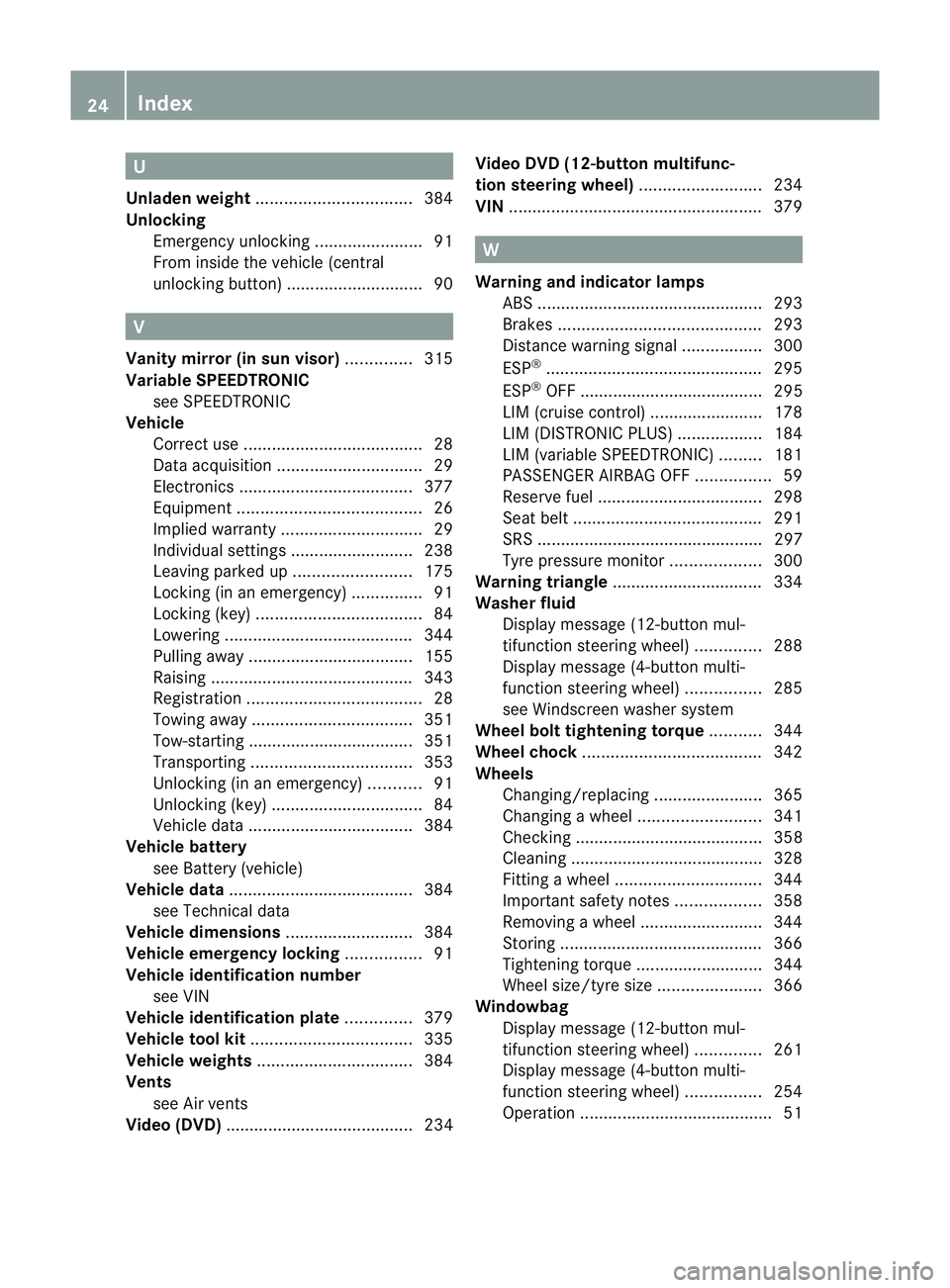
U
Unladen weight ................................. 384
Unlocking Emergency unlocking .......................91
From inside the vehicle (central
unlocking button) ............................. 90V
Vanity mirror (in sun visor) ..............315
Variable SPEEDTRONIC see SPEEDTRONIC
Vehicle
Correct use ...................................... 28
Data acquisition ............................... 29
Electronics ..................................... 377
Equipment ....................................... 26
Implied warranty .............................. 29
Individua lsettings .......................... 238
Leaving parked up .........................175
Locking (in an emergency) ...............91
Locking (key )................................... 84
Lowering ........................................ 344
Pulling away ................................... 155
Raising ........................................... 343
Registration ..................................... 28
Towing away .................................. 351
Tow-starting ................................... 351
Transporting .................................. 353
Unlocking (in an emergency) ...........91
Unlocking (key )................................ 84
Vehicle data ................................... 384
Vehicle battery
see Battery (vehicle)
Vehicle data ....................................... 384
see Technical data
Vehicle dimensions ...........................384
Vehicle emergency locking ................91
Vehicle identification number see VIN
Vehicle identification plate ..............379
Vehicle tool kit .................................. 335
Vehicle weights ................................. 384
Vents see Air vents
Video (DVD) ........................................ 234 Video DVD (12-button multifunc-
tion steering wheel)
..........................234
VIN ...................................................... 379 W
Warning and indicator lamps ABS ................................................ 293
Brakes ........................................... 293
Distance warning signa l................. 300
ESP ®
.............................................. 295
ESP ®
OFF ....................................... 295
LIM (cruise control) ........................ 178
LIM (DISTRONIC PLUS) ..................184
LIM (variable SPEEDTRONIC) .........181
PASSENGER AIRBAG OFF ................59
Reserve fuel ................................... 298
Seat bel t........................................ 291
SRS ................................................ 297
Tyr ep ressure monitor ...................300
Warning triangle ................................ 334
Washer fluid Display message (12-button mul-
tifunctio nsteering wheel) ..............288
Display message (4-button multi-
function steering wheel) ................285
see Windscreen washer system
Wheel bol ttightening torque ...........344
Wheel chock ...................................... 342
Wheels Changing/replacing .......................365
Changing awheel .......................... 341
Checking ........................................ 358
Cleaning ......................................... 328
Fitting awheel ............................... 344
Important safety notes ..................358
Removing awheel .......................... 344
Storing ........................................... 366
Tightening torque ........................... 344
Whee lsize/tyre size ...................... 366
Windowbag
Display message (12-button mul-
tifunctio nsteering wheel) ..............261
Display message (4-button multi-
function steering wheel) ................254
Operation ........................................ .5124
Index
Page 32 of 401
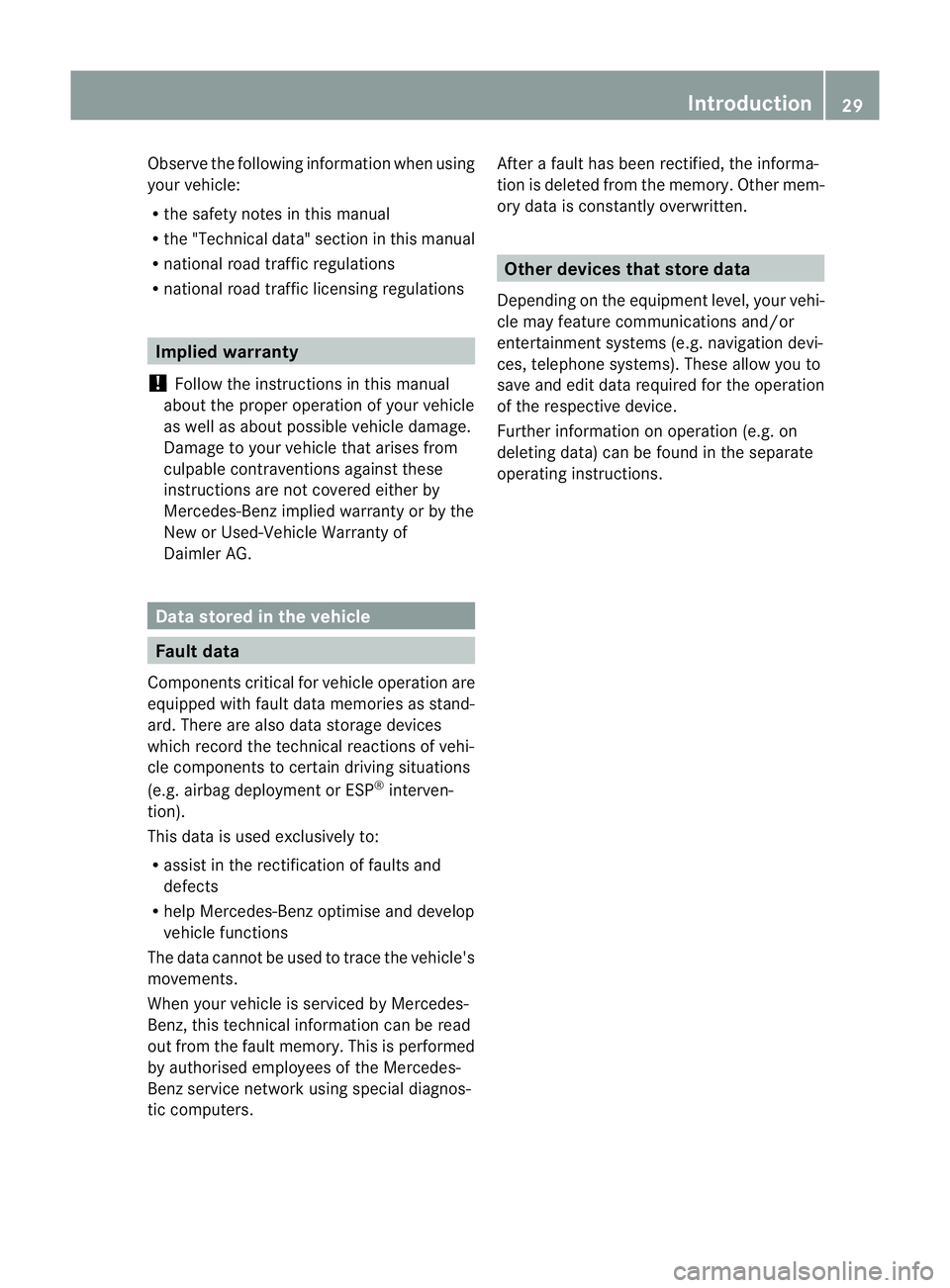
Observe the following information when using
your vehicle:
R the safety notes in this manual
R the "Technical data" section in this manual
R national road traffic regulations
R national road traffic licensing regulations Implied warranty
! Follow the instructions in this manual
aboutt he proper operation of your vehicle
as well as about possible vehicle damage.
Damage to your vehicle that arises from
culpable contraventions against these
instructions are not covered either by
Mercedes-Ben zimplied warranty or by the
New or Used-Vehicle Warranty of
Daimler AG. Data stored in the vehicle
Fault data
Components critical for vehicle operation are
equipped with fault data memories as stand-
ard. There are also data storage devices
which record the technical reactions of vehi-
cle components to certain driving situations
(e.g. airbag deployment or ESP ®
interven-
tion).
This data is used exclusively to:
R assist in the rectificatio noffaults and
defects
R help Mercedes-Ben zoptimise and develop
vehicle functions
The data cannot be used to trace the vehicle's
movements.
When your vehicle is serviced by Mercedes-
Benz, this technical information can be read
out from the fault memory. This is performed
by authorised employees of the Mercedes-
Ben zservice network using special diagnos-
tic computers. After a fault has been rectified, the informa-
tion is deleted from the memory. Other mem-
ory data is constantly overwritten. Other devices that store data
Depending on the equipment level, your vehi-
cle may feature communications and/or
entertainment systems (e.g. navigation devi-
ces, telephone systems). These allow you to
save and edit data required for the operation
of the respective device.
Further information on operation (e.g. on
deleting data) can be found in the separate
operating instructions. Introduction
29 Z
Page 45 of 401

Centre console
Function Page
:
Audio system/COMAND
Online; see separate oper-
ating instructions
;
c
Seat heating 109
=
s
Seat ventilation 110
?
c
PARKTRONIC 196
A
¤
ECO start/stop but-
ton 156
B
£
Hazard warning
lamps 121
C
4
PASSENGER AIRBAG
OFF indicator lamp 59
D
u
Saloon :rear window
roller sunblind 316
M
Dynamic driving
package with sports mode 192 Function Page
E
&
Auxiliary heating 143
M
Dynamic driving
package with sports mode 192
F
Stowage compartment 302
Ashtray 316
Cigarette lighter 317
Power socket 317
G
Gear lever 160
Selector lever 162
H
Stowage compartment 302
Cup holder 314
I
Stowage compartment 302
J
Audio/COMAND controller
K
Selects the drive program 16342
Centre consoleAt a glance
Page 49 of 401
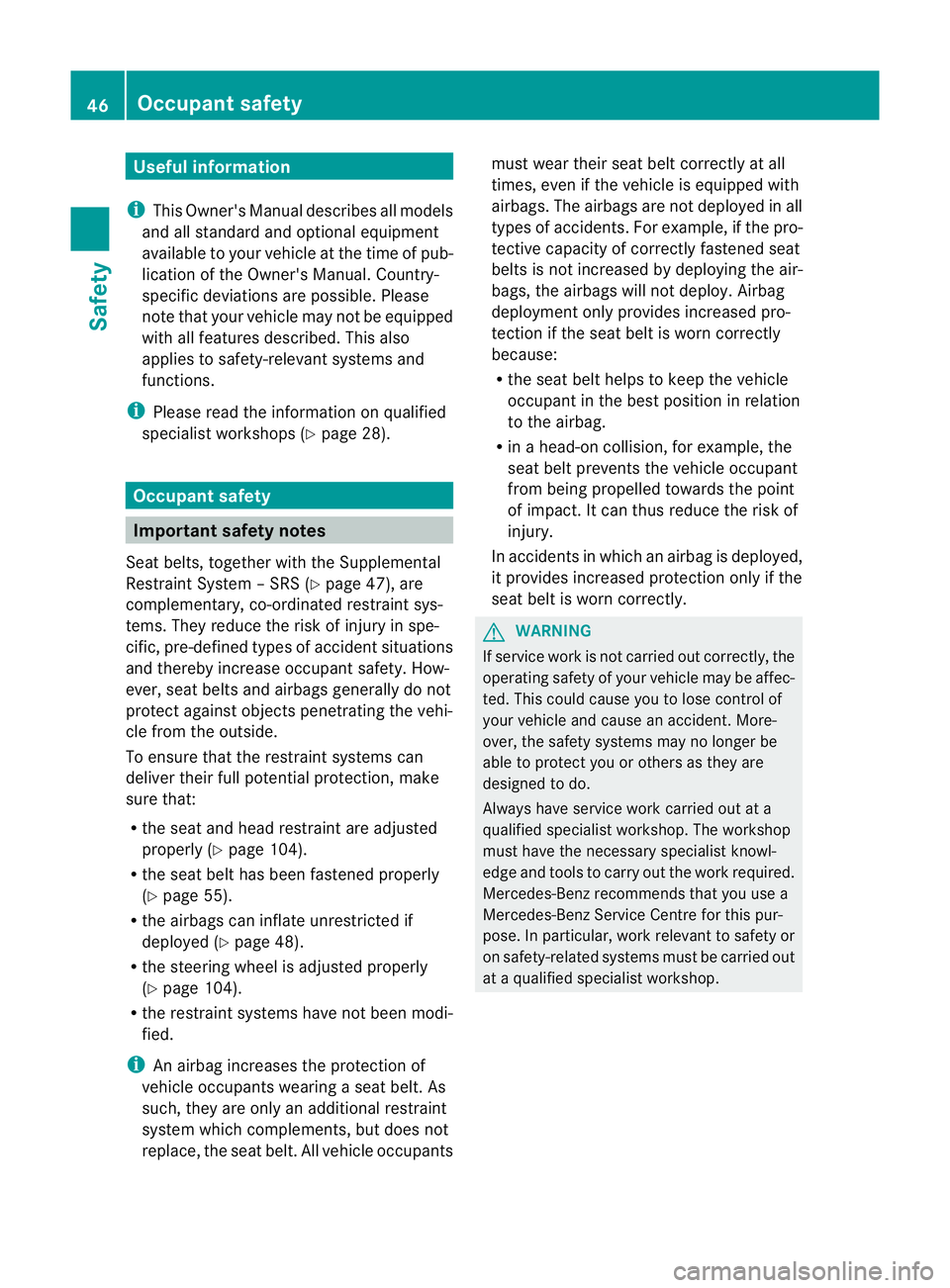
Useful information
i This Owner's Manual describes all models
and all standard and optional equipment
available to your vehicle at the time of pub-
lication of the Owner's Manual. Country-
specific deviations are possible. Please
note that your vehicle may not be equipped
with all features described. This also
applies to safety-relevan tsystems and
functions.
i Please read the information on qualified
specialist workshops (Y page 28).Occupant safety
Important safety notes
Seat belts, together with the Supplemental
Restraint System – SRS (Y page 47), are
complementary, co-ordinated restrain tsys-
tems .They reduce the risk of injury in spe-
cific, pre-defined types of accident situations
and thereby increase occupant safety. How-
ever, seat belts and airbags generally do not
protect against objects penetrating the vehi-
cle from the outside.
To ensure that the restraint systems can
deliver their full potential protection, make
sure that:
R the seat and head restraint are adjusted
properly (Y page 104).
R the seat belt has been fastened properly
(Y page 55).
R the airbags can inflate unrestricted if
deployed (Y page 48).
R the steering wheel is adjusted properly
(Y page 104).
R the restraint systems have not been modi-
fied.
i An airbag increases the protection of
vehicle occupants wearing a seat belt. As
such, they are only an additional restraint
system which complements, but does not
replace, the seat belt. All vehicle occupants must wear their seat belt correctly at all
times, even if the vehicle is equipped with
airbags. The airbags are not deployed in all
types of accidents. For example, if the pro-
tective capacity of correctly fastened seat
belts is not increased by deploying the air-
bags, the airbags will not deploy.A
irbag
deploymen tonly provides increased pro-
tection if the seat belt is worn correctly
because:
R the sea tbelt helps to keep the vehicle
occupan tinthe best position in relation
to the airbag.
R in a head-on collision, for example, the
seat belt prevents the vehicle occupant
from being propelled towards the point
of impact. It can thus reduce the risk of
injury.
In accidents in which an airbag is deployed,
it provides increased protection only if the
seat belt is worn correctly. G
WARNING
If service work is not carried out correctly, the
operating safety of your vehicle may be affec-
ted. This could cause you to lose control of
your vehicle and cause an accident. More-
over, the safety systems may no longer be
able to protect you or others as they are
designed to do.
Always have service work carried out at a
qualified specialist workshop. The workshop
must have the necessary specialist knowl-
edge and tools to carry out the work required.
Mercedes-Ben zrecommends that you use a
Mercedes-Benz Service Centre for this pur-
pose. In particular, work relevant to safety or
on safety-related systems must be carried out
at a qualified specialist workshop. 46
Occupant safetySafety
Page 50 of 401
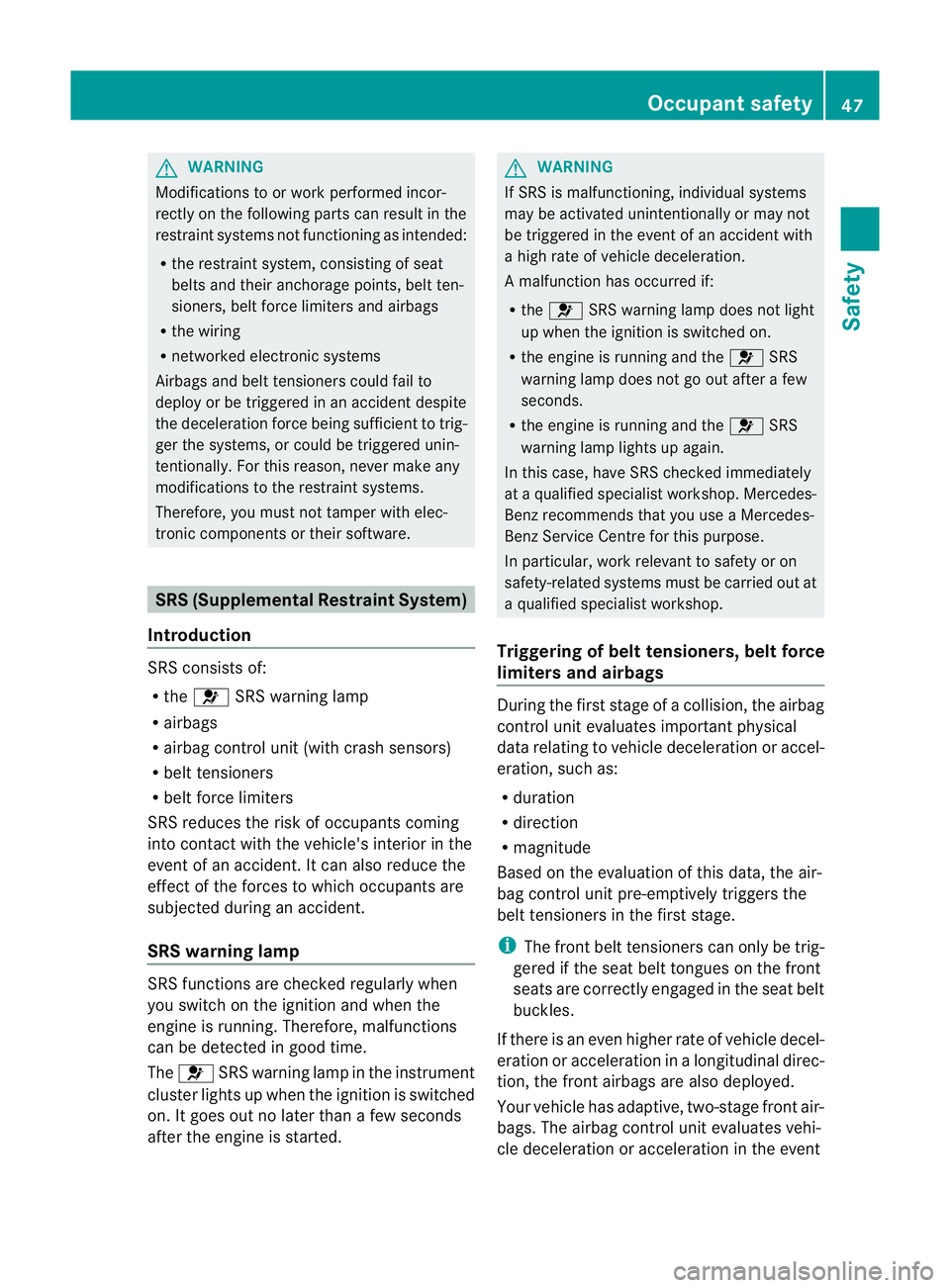
G
WARNING
Modifications to or work performed incor-
rectly on the following parts can result in the
restraint systems not functioning as intended:
R the restraint system, consisting of seat
belts and their anchorage points, beltt en-
sioners, belt force limiters and airbags
R the wiring
R networked electronic systems
Airbags and belt tensioners could fail to
deploy or be triggered in an acciden tdespite
the deceleration force being sufficien tto trig-
ger the systems, or could be triggered unin-
tentionally. For this reason, never make any
modifications to the restraint systems.
Therefore, you must not tamper with elec-
tronic components or their software. SRS (Supplemental Restraint System)
Introduction SRS consists of:
R
the 6 SRS warning lamp
R airbags
R airbag control unit (with crash sensors)
R belt tensioners
R belt force limiters
SRS reduces the risk of occupants coming
into contact with the vehicle's interior in the
event of an accident. It can also reduce the
effect of the forces to which occupants are
subjected during an accident.
SRS warning lamp SRS functions are checked regularly when
you switch on the ignition and when the
engine is running. Therefore, malfunctions
can be detected in good time.
The 6 SRS warning lamp in the instrument
cluster lights up when the ignition is switched
on. It goes out no later than a few seconds
after the engine is started. G
WARNING
If SRS is malfunctioning, individual systems
may be activated unintentionally or may not
be triggered in the event of an accident with
a high rate of vehicle deceleration.
A malfunction has occurred if:
R the 6 SRS warning lamp does not light
up when the ignition is switched on.
R the engine is running and the 6SRS
warning lamp does not go out after a few
seconds.
R the engine is running and the 6SRS
warning lamp lights up again.
In this case, have SRS checked immediately
at a qualified specialist workshop. Mercedes-
Benz recommends that you use a Mercedes-
Benz Service Centre for this purpose.
In particular, work relevant to safety or on
safety-related systems must be carried out at
a qualified specialist workshop.
Triggering of belt tensioners, belt force
limiters and airbags During the first stage of a collision, the airbag
control unit evaluates important physical
data relating to vehicle deceleration or accel-
eration, such as:
R
duration
R direction
R magnitude
Based on the evaluation of this data, the air-
bag control unit pre-emptively triggers the
belt tensioners in the first stage.
i The front belt tensioners can only be trig-
gered if the seat belt tongues on the front
seats are correctly engaged in the seat belt
buckles.
If there is an even higher rate of vehicle decel-
eration or acceleration in a longitudinal direc-
tion, the front airbags are also deployed.
Your vehicle has adaptive, two-stage front air-
bags. The airbag control unit evaluates vehi-
cle deceleration or acceleration in the event Occupant safety
47Safety Z
Page 51 of 401
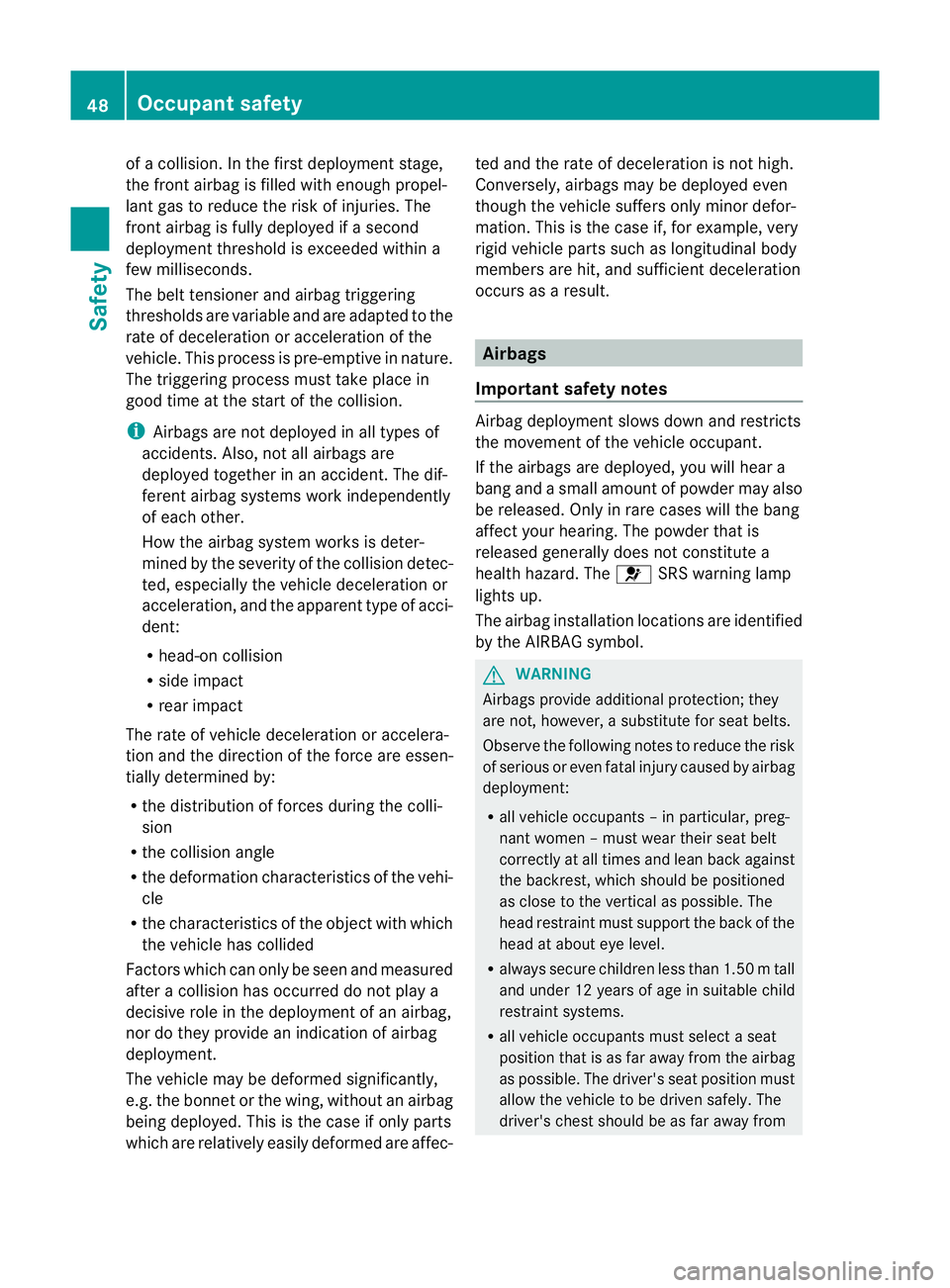
of a collision. In the first deployment stage,
the front airbag is filled with enough propel-
lant gas to reduce the risk of injuries. The
front airbag is fully deployed if a second
deployment threshold is exceeded within a
few milliseconds.
The belt tensioner and airbag triggering
thresholds are variable and are adapted to the
rate of deceleration or acceleration of the
vehicle. This process is pre-emptive in nature.
The triggering process must take place in
good time at the start of the collision.
i Airbags are not deployed in all types of
accidents. Also, not all airbags are
deployed together in an accident .The dif-
ferent airbag systems work independently
of each other.
How the airbag system works is deter-
mined by the severity of the collision detec-
ted, especially the vehicle deceleration or
acceleration, and the apparent type of acci-
dent:
R head-on collision
R side impact
R rear impact
The rate of vehicle deceleration or accelera-
tion and the direction of the force are essen-
tially determined by:
R the distribution of forces during the colli-
sion
R the collision angle
R the deformation characteristics of the vehi-
cle
R the characteristics of the object with which
the vehicle has collided
Factors which can only be seen and measured
after a collision has occurred do not play a
decisive role in the deployment of an airbag,
nor do they provide an indication of airbag
deployment.
The vehicle may be deformed significantly,
e.g. the bonnet or the wing, without an airbag
being deployed. This is the case if only parts
which are relatively easily deformed are affec- ted and the rate of deceleration is not high.
Conversely, airbags may be deployed even
though the vehicle suffers only minor defor-
mation. This is the case if, for example, very
rigid vehicle parts such as longitudinal body
members are hit, and sufficient deceleration
occurs as a result.
Airbags
Important safety notes Airbag deployment slows down and restricts
the movement of the vehicle occupant.
If the airbags are deployed, you will hear a
bang and a small amount of powder may also
be released. Only in rare cases will the bang
affect your hearing. The powder that is
released generally does not constitute a
health hazard. The
6SRS warning lamp
lights up.
The airbag installation locations are identified
by the AIRBAG symbol. G
WARNING
Airbags provide additional protection; they
are not, however, a substitute for seat belts.
Observe the following notes to reduce the risk
of serious or even fatal injury caused by airbag
deployment:
R all vehicle occupants –inparticular, preg-
nant women – must wear their seat belt
correctly at all times and lean back against
the backrest, which should be positioned
as close to the vertical as possible. The
head restraint must support the back of the
head at about eye level.
R always secure childre nless than 1.50mt all
and unde r12years of age in suitable child
restraint systems.
R all vehicle occupants must select a seat
position that is as far away from the airbag
as possible. The driver's seat position must
allow the vehicle to be driven safely. The
driver's chest should be as far away from 48
Occupant safetySafety
Page 52 of 401
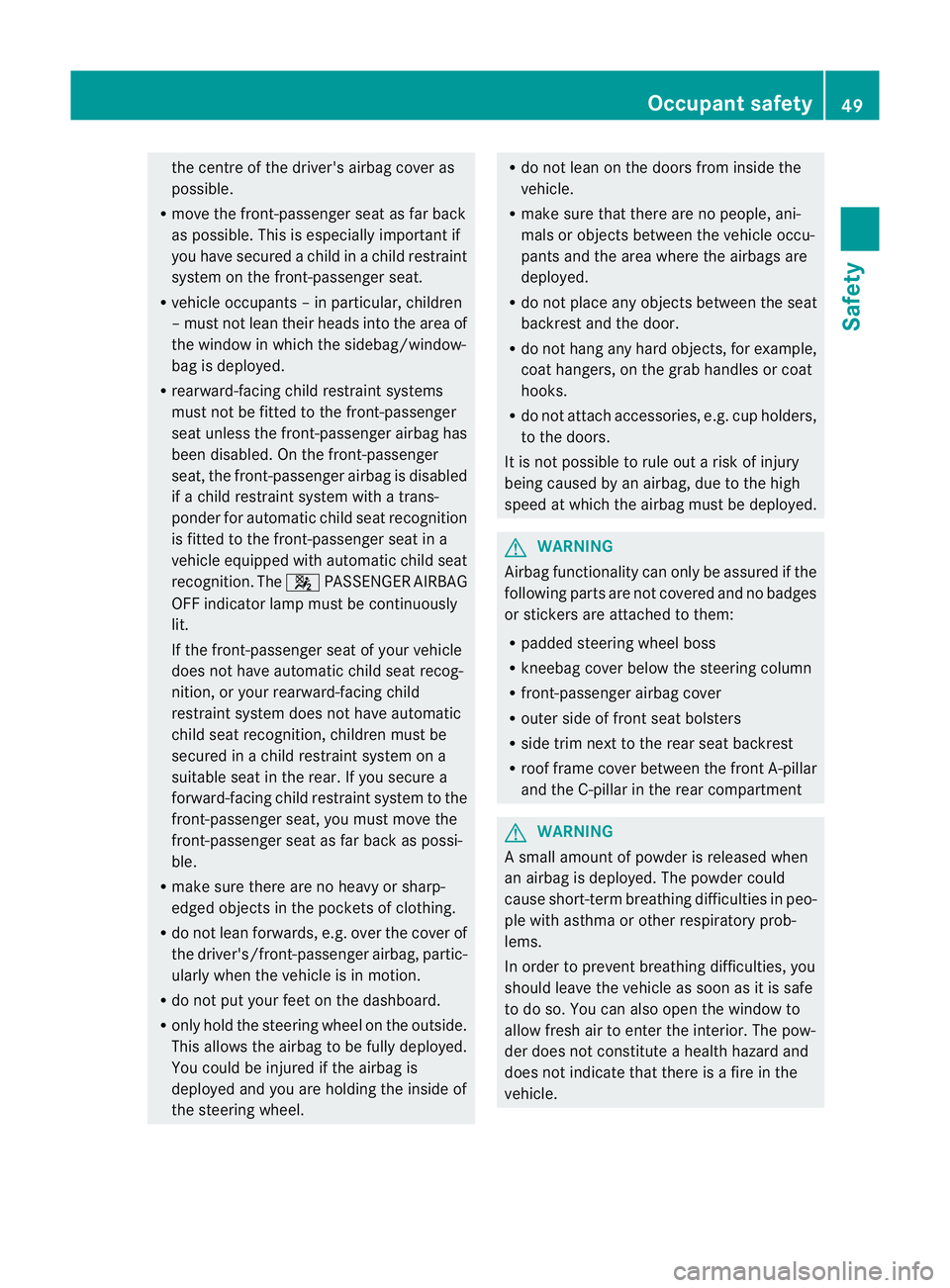
the centre of the driver's airbag cover as
possible.
R move the front-passenger seat as far back
as possible. This is especially important if
you have secured a child in a child restraint
syste mont he front-passenger seat.
R vehicle occupants –inparticular, children
–m ust no tlean their heads into the area of
the window in which the sidebag/window-
bag is deployed.
R rearward-facing child restraint systems
must not be fitted to the front-passenger
seat unless the front-passenger airbag has
been disabled. On the front-passenger
seat, the front-passenger airbag is disabled
if a child restraint system with a trans-
ponder for automatic child seat recognition
is fitted to the front-passenger seat in a
vehicle equipped with automatic child seat
recognition. The 4PASSENGER AIRBAG
OFF indicator lamp must be continuously
lit.
If the front-passenger seat of your vehicle
does not have automatic child seat recog-
nition, or your rearward-facing child
restraint system does not have automatic
child seat recognition, children must be
secured in a child restraint system on a
suitable seat in the rear. If you secure a
forward-facing child restraint system to the
front-passenger seat, you must move the
front-passenger seat as far back as possi-
ble.
R make sure there are no heavy or sharp-
edged objects in the pockets of clothing.
R do not lean forwards, e.g. over the cover of
the driver's/front-passenger airbag, partic-
ularly when the vehicle is in motion.
R do not put your feet on the dashboard.
R only hold the steering wheel on the outside.
This allows the airbag to be fully deployed.
You could be injured if the airbag is
deployed and you are holding the inside of
the steering wheel. R
do not lean on the doors from inside the
vehicle.
R make sure that there are no people, ani-
mals or objects between the vehicle occu-
pants and the area where the airbags are
deployed.
R do not place any objects between the seat
backrest and the door.
R do not hang any hard objects, for example,
coat hangers, on the grab handles or coat
hooks.
R do not attach accessories, e.g. cup holders,
to the doors.
It is not possible to rule out a risk of injury
being caused by an airbag, due to the high
speed at which the airbag must be deployed. G
WARNING
Airbag functionality can only be assured if the
following parts are not covered and no badges
or stickers are attached to them:
R padded steering wheel boss
R kneebag cover below the steering column
R front-passenger airbag cover
R outer side of fron tseat bolsters
R side trim next to the rear seat backrest
R roof frame cover between the fron tA-pillar
and the C-pillar in the rear compartment G
WARNING
As mall amount of powder is released when
an airbag is deployed. The powder could
cause short-term breathing difficulties in peo-
ple with asthma or other respiratory prob-
lems.
In order to prevent breathing difficulties, you
should leave the vehicle as soon as it is safe
to do so. You can also open the window to
allow fresh air to enter the interior. The pow-
der does not constitute ahealth hazard and
does not indicate that there is a fire in the
vehicle. Occupant safety
49Safety Z
Page 53 of 401
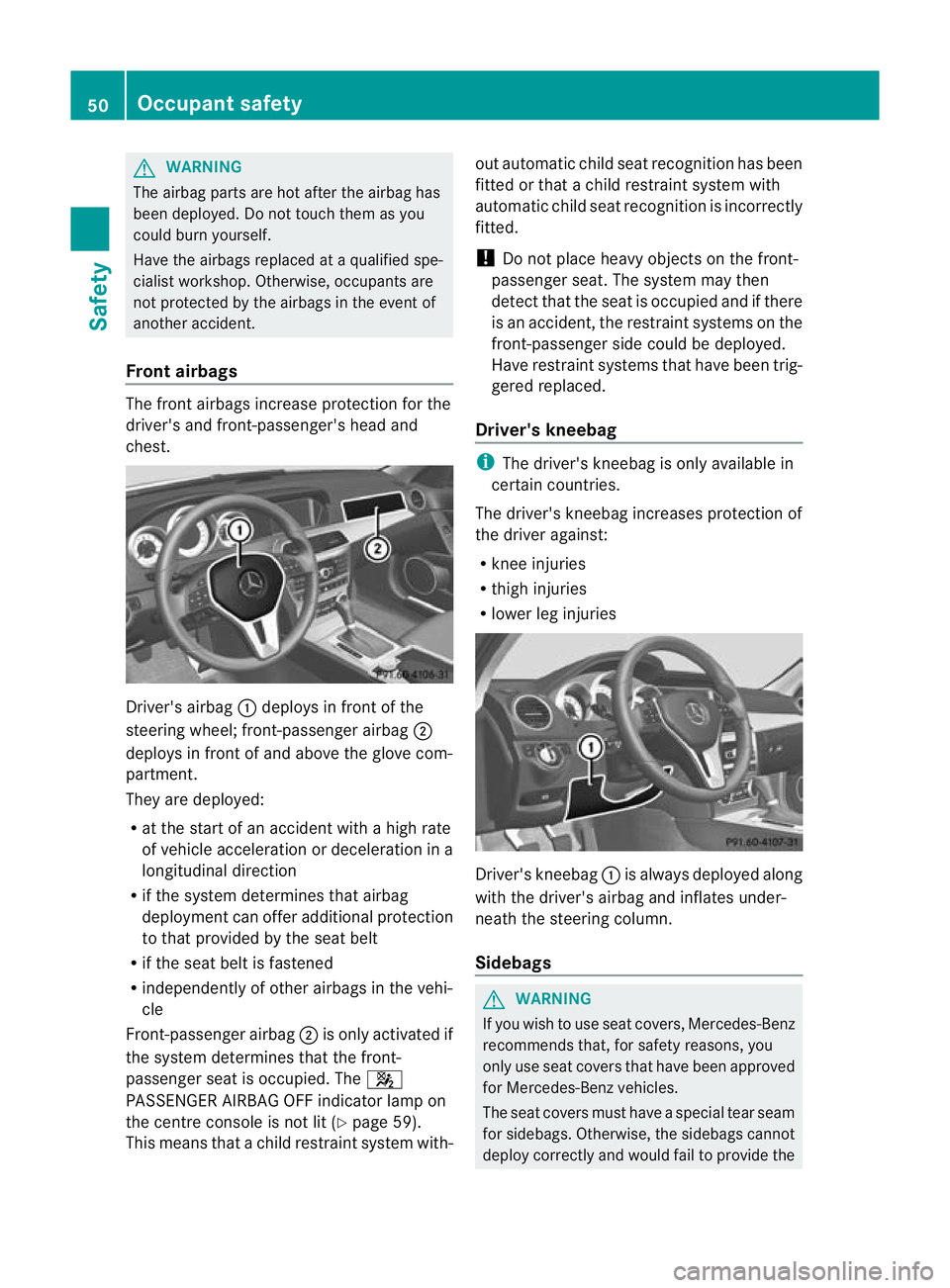
G
WARNING
The airbag parts are hot after the airbag has
been deployed. Do not touch them as you
could burn yourself.
Have the airbags replaced at a qualified spe-
cialist workshop. Otherwise, occupants are
not protected by the airbags in the event of
another accident.
Fron tairbags The fron
tairbags increase protection for the
driver's and front-passenger's head and
chest. Driver's airbag
:deploys in front of the
steering wheel; front-passenger airbag ;
deploys in front of and above the glove com-
partment.
They are deployed:
R at the start of an accident with a high rate
of vehicle acceleration or deceleration in a
longitudinal direction
R if the system determines that airbag
deploymen tcan offer additional protection
to that provided by the seat belt
R if the seat belt is fastened
R independently of other airbag sinthe vehi-
cle
Front-passenger airbag ;is only activated if
the system determines that the front-
passenger seat is occupied. The 4
PASSENGER AIRBAG OFF indicator lamp on
the centre console is not lit (Y page 59).
This means that a child restraint system with- out automatic child seat recognition has been
fitted or that a child restraint system with
automatic child seat recognition is incorrectly
fitted.
!
Do not place heavy objects on the front-
passenger seat. The system may then
detect that the seat is occupied and if there
is an accident, the restraint systems on the
front-passenger side could be deployed.
Have restraint systems that have been trig-
gered replaced.
Driver's kneebag i
The driver's kneebag is only available in
certain countries.
The driver's kneebag increases protection of
the driver against:
R knee injuries
R thigh injuries
R lower leg injuries Driver's kneebag
:is always deployed along
with the driver's airbag and inflates under-
neath the steering column.
Sidebags G
WARNING
If you wish to use seat covers, Mercedes-Benz
recommends that, for safety reasons, you
only use seat covers that have been approved
for Mercedes-Ben zvehicles.
The seat covers must have a special tear seam
for sidebags. Otherwise, the sidebags cannot
deploy correctly and would fail to provide the 50
Occupant safetySafety